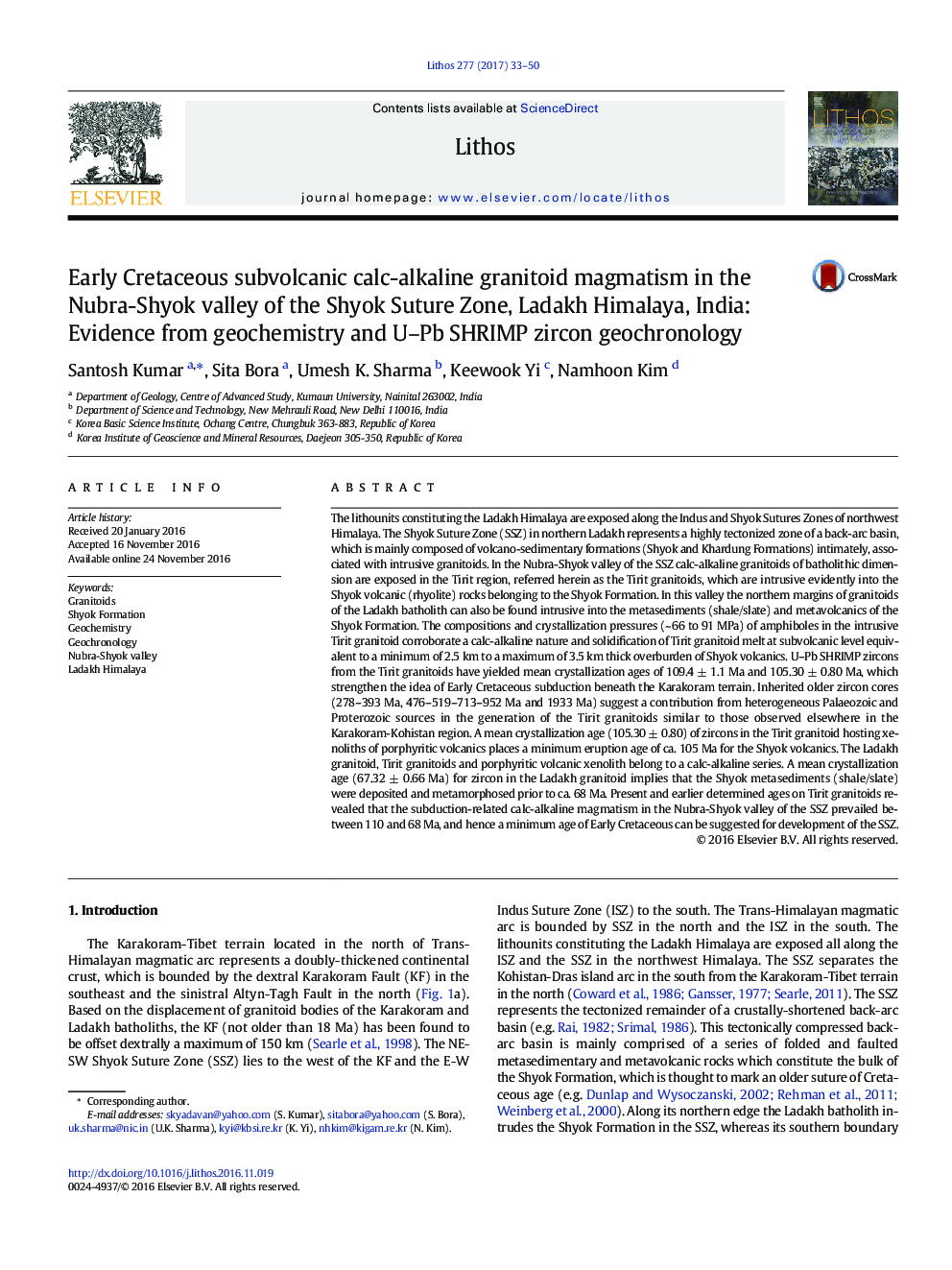| کد مقاله | کد نشریه | سال انتشار | مقاله انگلیسی | نسخه تمام متن |
|---|---|---|---|---|
| 5784079 | 1638633 | 2017 | 18 صفحه PDF | دانلود رایگان |

- Field and geobarometric (~Â 56 to 129Â MPa) evidence corroborates solidification of Tirit granitoid melt at subvolcanic level.
- Ages (109.4 ± 1.1, 105.3 ± 0.8 Ma) and calc-alkaline nature of Tirit granitoids record Early Cretaceous (> 110 Ma) subduction.
- A minimum age of Albian for Shyok volcanics and Maastrichtian for Shyok metasediments is suggested.
- Palaeozoic to Proterozoic inherited zircons imply role of heterogeneous sources in the formation of Tirit granitoid melts.
The lithounits constituting the Ladakh Himalaya are exposed along the Indus and Shyok Sutures Zones of northwest Himalaya. The Shyok Suture Zone (SSZ) in northern Ladakh represents a highly tectonized zone of a back-arc basin, which is mainly composed of volcano-sedimentary formations (Shyok and Khardung Formations) intimately, associated with intrusive granitoids. In the Nubra-Shyok valley of the SSZ calc-alkaline granitoids of batholithic dimension are exposed in the Tirit region, referred herein as the Tirit granitoids, which are intrusive evidently into the Shyok volcanic (rhyolite) rocks belonging to the Shyok Formation. In this valley the northern margins of granitoids of the Ladakh batholith can also be found intrusive into the metasediments (shale/slate) and metavolcanics of the Shyok Formation. The compositions and crystallization pressures (~ 66 to 91 MPa) of amphiboles in the intrusive Tirit granitoid corroborate a calc-alkaline nature and solidification of Tirit granitoid melt at subvolcanic level equivalent to a minimum of 2.5 km to a maximum of 3.5 km thick overburden of Shyok volcanics. U-Pb SHRIMP zircons from the Tirit granitoids have yielded mean crystallization ages of 109.4 ± 1.1 Ma and 105.30 ± 0.80 Ma, which strengthen the idea of Early Cretaceous subduction beneath the Karakoram terrain. Inherited older zircon cores (278-393 Ma, 476-519-713-952 Ma and 1933 Ma) suggest a contribution from heterogeneous Palaeozoic and Proterozoic sources in the generation of the Tirit granitoids similar to those observed elsewhere in the Karakoram-Kohistan region. A mean crystallization age (105.30 ± 0.80) of zircons in the Tirit granitoid hosting xenoliths of porphyritic volcanics places a minimum eruption age of ca. 105 Ma for the Shyok volcanics. The Ladakh granitoid, Tirit granitoids and porphyritic volcanic xenolith belong to a calc-alkaline series. A mean crystallization age (67.32 ± 0.66 Ma) for zircon in the Ladakh granitoid implies that the Shyok metasediments (shale/slate) were deposited and metamorphosed prior to ca. 68 Ma. Present and earlier determined ages on Tirit granitoids revealed that the subduction-related calc-alkaline magmatism in the Nubra-Shyok valley of the SSZ prevailed between 110 and 68 Ma, and hence a minimum age of Early Cretaceous can be suggested for development of the SSZ.
Journal: Lithos - Volume 277, 15 April 2017, Pages 33-50